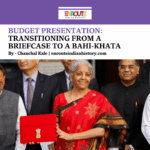
By Chanchal Kale
Bollywood, bursting with energy, iconic dance sequences, and contagious melodies, has woven itself into the very fabric of Indian identity around the globe. The vibrant streets of Bombay, the heart of India’s film industry, are adorned with colourful film posters that seem to leap off the walls. Yet, amid this visual spectacle, a striking pattern emerged: most posters featured male leads, reflecting a deeply entrenched male dominance in the industry. 1960s and 1970s were the decades when Bollywood almost became synonymous to the imagery of an “Angry Young Man”.
Amidst this sea of masculine representation, a legendary figure rose to prominence, refusing to be overshadowed. Sridevi—an unparalleled talent who not only shattered records but also transformed the landscape of Indian cinema. With her captivating charm and powerhouse performances, she didn't just navigate a male-dominated world; she reigned over it like a true Diva, earning her rightful title as the First Female Superstar. Her legacy continues to inspire and resonate, reminding us of the powerful impact a single individual can have on an entire industry.
A Journey to Become a Legend
Shree Amma Yanger Ayyapan, born on August 13, 1963, adopted the name Sridevi upon entering the film industry. Over the course of her 54-year life, she dedicated nearly 50 years to her career. Sridevi began as a child artist in Southern cinema, making her debut in the Tamil film “Kandhan Karunai” at the tender age of 4. In other words, she literally grew up on set, acting alongside legendary directors and actors. At the age of 13, she landed her first leading role in the film "Moondru Mudichu," released in 1976, which was directed by K. Balachander and starred Rajinikanth, Kamal Haasan, and herself. Over the years, Sridevi and Rajinikanth appeared in approximately 22 films together, all of which became box-office successes.
As a child, Sridevi found herself surrounded by legends and was only vaguely aware of their stature. This environment made acting with them feel like child’s play. Amborish Roychowdhury, author of the book "Sridevi: The South Years," asserts that her experiences in Southern cinema helped her become Bollywood’s first female superstar. As critic Baradwaj Rangan notes in Roychowdhury’s book, “The film industry was a university for her.”
Sridevi made her Bollywood debut in 1978 with “Solva Saavan,” but it was her performance in the 1983 Jeetendra-starrer "Himmatwala" that brought her significant commercial success. Her captivating eyes, vibrant screen presence, and acting talent quickly made her one of the most sought-after actresses in the Hindi film industry. While films like "Mawaali" (1983), "Tohfa" (1984), "Mr. India" (1987), and "Chandni" (1989) kept her at the top of the box office, her roles in projects like "Sadma" (1983), "ChaalBaaz" (1989), "Lamhe" (1991), and "Gumrah" (1993) earned her critical acclaim. Interestingly, it wasn’t until the release of “Chandni” that Sridevi began dubbing her own voice, as actress Naaz had provided her voice in earlier films due to Sridevi’s limited command over Hindi. In "Chandni," she not only sang a song but also made it a super hit melody, showcasing her determination and talent. The 1987 film “Mr. India” epitomized her versatility as she portrayed a quirky journalist, creating a memorable character which nearly overshadowed her co-star, Anil Kapoor. Critics humorously remarked that the film should have been titled “Miss India.”
The real turning point in her career came with the release of “Nagina” in 1986, which centred around a female lead. The film captivated audiences with Sridevi's portrayal of an “Icchadhari Nagin” (shape-shifting serpent) seeking revenge. It proved that a female-led film could dominate the box office in a male-dominated industry. Notably, film posters across the country began to feature Sridevi prominently, placing her in the spotlight alongside her male co-stars.
The topic of pay parity based on gender continues to be relevant today. Remarkably, Sridevi was paid more than her male counterparts in four films: "Gumrah," "Army," "Mr. India," and "Nagina." While this might not seem significant now, it was a
considerable achievement at a time when feminism as a concept was not widely recognized. In “Josheelay” (1989), Sridevi was cast alongside leading male actors Sunny Deol and Anil Kapoor. However, both of them struggled to hold their roles against her powerful presence. Hailed as the female Bachchan, there are rumours that she even negotiated terms for a double role in “Khuda Gawah.” Her influence was evident in a magazine cover story titled “Is Sridevi a Hero?” (Showtime, September 1987).
Sridevi's charisma transcended borders and reached Hollywood; Steven Spielberg offered her a role in the classic “Jurassic Park.” She declined the offer for reasons unknown, leading critics to speculate that it was not a starring role and that accepting it would have required a hiatus from Bollywood at a time when she was at the height of her career.
Following her reign in the industry, Sridevi embraced domesticity and took a 15-year hiatus after the success of “Judai.” However, her stardom remained intact during this break. In 2013, she made a remarkable comeback in Bollywood with "English Vinglish," which became one of the year’s biggest hits. Her final film was the crime thriller “Mom,” which earned her the National Film Award for Best Actress. Regardless of whether her films were blockbusters or flops, Sridevi's talent was never in question. She was honoured with the Padma Shri in 2013. She was a shy woman who transformed into a screen goddess once the camera started rolling—truly India’s first female superstar, a woman who not only outshone her male contemporaries but also created a lasting legacy.
Circumstances Favouring Her Rise
There were indeed other actresses in the industry before Sridevi who had the potential to become superstars. However, as people often say, Sridevi was in the right place at the right time. The 1980s and 90s marked the decline of the "Angry Young Man" era, which created
more opportunities for female actors to shine.
The late 1970s and early 1980s marked a fascinating transformation in Bollywood, largely influenced by a wave of talented filmmakers from South India, including prominent figures like K. Raghavendra Rao and T. Rama Rao. Among them was Sridevi, who had already established herself in Tamil, Telugu, Malayalam, and Kannada cinema before stepping into the Bollywood spotlight. These Southern filmmakers often preferred to cast actors who had previously worked with their teams. Sridevi's incredible rise was significantly fueled by her roles in remakes of popular Tamil films, frequently directed by the same creative teams behind the originals. A standout film from this era was “Sadma,” which is a poignant remake
of the Tamil classic “Mundram Pirai.”
Until the 1980s, the South Indian film industry felt somewhat isolated from the glamour of Bollywood. However, Sridevi’s remarkable ability to transcend regional and linguistic boundaries helped her cultivate a pan-Indian fan base. During this vibrant period, she made a significant impact in the Masala film genre, which artfully blended action, romance, and comedy, showcasing her incredible range and versatility.
Take “Mr. India,” for example; she dazzled audiences with her stunning dance in the iconic number “Hawa Hawai,” showcased her comedic flair by channeling Charlie Chaplin, and exuded charm and sensuality in “Tip Tip Barsa Pani.” As if that weren't enough, she even demonstrated her vocal skills by performing a parody that highlighted her multifaceted talent. Sridevi was, without a doubt, the actress who delivered whatever filmmakers envisioned. As the economic landscape shifted in the late 1980s and early 1990s, ushering in an era of consumerism and globalization, Sridevi emerged as a beacon of glamour, fashion, and modernity. She became one of the first actresses to endorse major brands, reflecting a
significant evolution in celebrity culture. However, the journey to superstardom was not without competition. The talented Jayaprada also emerged from the South, and the rivalry between these two actresses generated intense media attention. Yet it was Sridevi's impeccable timing that truly set her apart in this competitive landscape.
Interestingly, the film “Nagina,” which revolved around a strong female lead, was initially offered to Jayaprada. However, she hesitated in making her decision. This film had the potential to catapult its female lead into superstardom, and many critics speculate that if Jayaprada had accepted the role, she might have become the reigning queen of Bollywood throughout the 1980s and 90s. In the ever-evolving world of cinema, timing can indeed be
everything!
Conclusion
The passing of the superstar at just 54 years of age due to a heart attack sent shockwaves across the nation. Her mesmerizing dance numbers had the entire country moving to their rhythms, and her loss was felt deeply by all. Sridevi's illustrious cinematic journey spanned more than five decades, gracing nearly 300 films in Hindi, Telugu, Tamil, Malayalam, and Kannada. She stood out as one of the few multilingual artists to soar to stardom across various regional film industries.
But her rise wasn’t mere fortune; it was fuelled by immense talent, unwavering intention, and a fierce determination to seize every opportunity that came her way. Her influence remains indelibly etched in the hearts of her fans, ensuring that her legacy is nothing short of immortal. The legend lives on—whether as the enchanting Chandini or the unforgettable Hawa Hawai girl—Sridevi continues to inspire through her art, forever a part of our cultural tapestry.
Bibliography
1. Amborish Roychoudhury, “Sridevi: The South Years”, Rupa Publications, August 2023
2. Sreedhar Pillai and Raj Chemgappa, “When Sridevi Emerged as the Highest Paid Indian Actress”, India Today Magazine, 25 Feb, 2018,
https://www.indiatoday.in/magazine/society-the-arts/films/story/19870630-sridevi-emerges-as-the-undisputed-empress-of-tinsel-town-the-highest-paid-indian-actress-799027-1987-06-29
3. “Sridevi: The Actress who made her male co-stars feel insecure”, Economic Times, 25 Feb, 2018, https://m.economictimes.com/magazines/panache/sridevi-the-actress-who-made-her-male-co-stars-feel-insecure/familyfirst/slideshow/63066552.cms
4. Bharani Vaitheesvaran, “Sridevi charmed a nation with her talent and ease of acting”, Economic Times, 26 Feb, 2018,
https://m.economictimes.com/magazines/panache/sridevi-charmed-a-nation-with-her-talent-and-ease-of-acting/articleshow/63074944.cms
5. “An enigma called Sridevi: Bollywood’s first female superstar would have turned 60 today”, The Tribune, 13 Aug, 2023, https://www.tribuneindia.com/news/features/an-enigma-called-sridevi-bollywoods-first-female-superstar-would-have-turned-60-
today-534594/
6. “How Sridevi Became India’s First Female Superstar”, News 18, September 26, 2024,
https://www.news18.com/movies/how-sridevi-became-indias-first-female-superstar-9064258.html
7. Sandeep, “Remembering the Legendary Sridevi: A Cinematic Icon's Timeless Legacy”, Hans News Service, 24 Feb 2024 12:01 PM IST
https://www.thehansindia.com/cinema/remembering-the-legendary-sridevi-a-cinematic-icons-timeless-legacy-860666
8. Prathyush Parashuraman, “Reading Sridevi: Understanding her Legacy through literature”, Film Companion, 24 Feb, 2020,
https://www.filmcompanion.in/features/reading-sridevi-understanding-her-legacy-through-literature
9. https://www.ottplay.com/news/listicle/legacy-of-sridevi-revisiting-her-iconic-films-on-her-61st-birthday-anniversary/1bf0d97cb8629
10. https://m.imdb.com/name/nm0004437/bio/
11. https://www.bollywoodlife.com/news-gossip/when-sridevi-was-called-the-lady-bachchan-for-getting-paid-more-than-these-actors-1166460/
12. https://www.india.com/entertainment/first-indian-actress-sridevi-who-charged-rs-1-crore-per-film-paid-more-than-rajinikanth-other-superstars-its-not-rekha-madhuri-dixit-juhi-chawla-7280434/



















